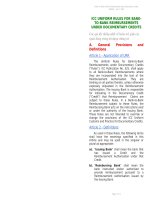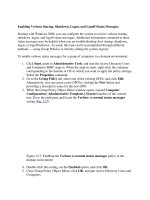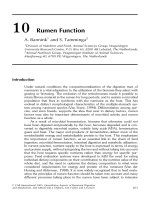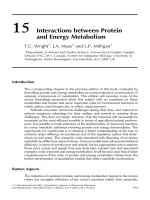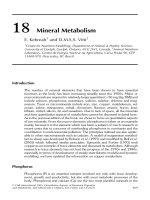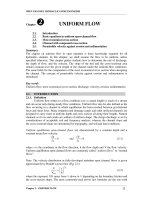Tài liệu Make-up Solvent Considerations for Prep and Semi-Prep LC/MS Mass-Based .... doc
Bạn đang xem bản rút gọn của tài liệu. Xem và tải ngay bản đầy đủ của tài liệu tại đây (585.91 KB, 14 trang )
August 2003 Page 1 of 14 319306-01
Introduction
Solvent choices for electrospray ionization can be separated from those of column separation for
systems utilizing a make-up solvent technique to provide required dilution. The following application
note takes a look at a few common solvent systems and their eects on a set of pharmaceutical target
compounds and related analytes.
What was Investigated
Mass-based fraction collection solvent selection for electrospray positive ionization mode was tested
for a limited set of solvents against a small set of analytes to show examples of solvent choice on
results. Often in prep analysis, unlike analytical work, compromises are made in ionization mode and
HPLC conditions to suit a broad number of compounds. In this Application Note, we will look at some
of these compromises in terms of ionization.
Main Components: Gilson-Thermo Finnigan NEBULA™ Prep System, consisting of a Gilson 215 Liquid
Handler/Autosampler/Fraction Collector, 322 H2 Prep Pump, 307 Make-up Pump, 155 UV/VIS Dual-
wavelength Detector with 0.2-mm ow cell, and Thermo Finnigan MSQ Mass Spectrometer.
Experimental—HPLC/LCMS
Six solutions of analytes were prepared (10 mg/mL of each compound) in DMSO, which oers at least
moderate separation for most analytes. All injection volumes were 500 µL on a 2-mL loop.
Column: Metachem 21*50 ODS2. Flow rate: 20 mL/min.; gradient: 5% MEOH/95%Water + 0.1%
HCOOH to 95% MEOH/5% Water +0.1%HCOOH in 10 minutes. Retention time estimates from
screening analysis on a ZORBAX 4.6*50-mm column at 1.5 mL/min. using the same gradient.
Make-up Flow Rate: 0.4 mL/min.
Splitter: Standard LC-Packings/standard ACM 10–50; UV = 254nm.
MS Conditions: Electrospray positive ionization mode. Capillary voltage: 3kV; cone voltage varied for
experimental purposes. Capillary temperature (525°C) was determined to give optimal signal for all
solvents. Scan range: 100–900 amu; scan rate: 0.8 sec. Cone stepping runs: 20V, 40V, 65V, and 95V at 1
sec.
Make-up Solvent Considerations for
Prep and Semi-Prep LC/MS Mass-Based
Fraction Collection
Materials & Methods
Application Note 206
Tim Hegeman (Gilson, Inc.)
Experiments: Collections performed for all solvents were tested for all mixes. Each system was run with
four cone voltages to look at solvent inuence.
Note: System is a solvent system identied by its organic constituent: MEOH, ACN, IPA, or MEOH/1,4
Dioxane. One representative mix from each system was chosen for the cone voltage experiment as
indicated.
August 2003 Page 2 of 14 319306-01
Make-up 1 Solvent A Solvent B Acid
Methanol % Water % HCOOH %
100 0 0.10
90 10 0.10
75 25 0.10
X 50 50 0.10
Make-up 2 Solvent A Solvent B Acid
Acetonitrile % Water % HCOOH %
100 0 0.10
90 10 0.10
75 25 0.10
X 50 50 0.10
Make-up 3 Solvent A Solvent B Acid
IPA % Water % HCOOH %
100 0 0.10
90 10 0.10
75 25 0.10
X 50 50 0.10
Make-up 4 Solvent A Solvent B Solvent Acid
1,4 Dioxane % Methanol % Water % HCOOH %
X 25 25 50 0.10
Make-up ow = 0.4 mL/min.
HCOOH = Formic Acid
% = v/v
X = Mix chosen to represent system for cone voltage change
This change was a sequential step of voltages at 20, 40, 65, and 95V
Table 1: Experimental—Make-up Solvents Tested
Photo 1: Gilson-Thermo Finnigan NEBULA™ Prep System
August 2003 Page 3 of 14 319306-01
Figure 1: Single-Injection LC/MS System
Figure 2: Make-up Splitter Allows Solvent Choices
Dilution Factor= mass split(1000) * make-up ow/prep ow
Dilution Factor = (1000 * 0.4 mL/min.)/20 mL/min. = 20
Low-Mount, Low-Pressure Valve
(not shown installed in spring clamp)
215 Liquid Handler
NC
COMM
NO
819
Injection
Module
to wast
e
to wast
e
Column
Outlet
Pump
UV/VIS Detector
Outlet
Inlet
Semi-Pre
p
Filter Assembly
Make-up
Pump
low flow to high
flow mass spectro
collec
t
Flow Splitter
Finnigan MSQ™
Inlet
Inlet
August 2003 Page 4 of 14 319306-01
Mix 1 in DMSO
Compound RT RT MW* ion MH+
RT from screen Window
1 Niacinamide 0.6 1.5-2.5 122 123
2 4-Acetaminophen 2.9 2.3-3.5 151 152
3 Caff
eine 4.9 4.7-5.4 194 195
4* Salicyclic acid acetate 5.8 5.6-6.3 180 none
5 Verapamil 6.7 6.5-7.5 454 455
6 N
ifedaphine 7.9 7.7-8.1 346 347
* MW Molecular Weight
* RT Retention time min.
* MH+ Protonated ion
4* Salicyclic acid acetate not analyzed for
OH
NH
O
CH
3
2
N
O
NH
2
1
N
N
O
O
CH
3
CH
3
N
N
CH
3
3
O OH
O C
H
3
O
4
N
+
O
-
O
N
H
CH
3
CH
3
O CH
3
O
O
O
CH
3
6
O
O
CH
3
CH
3
CH
3
CH
3
N
N
CH
3
O
O
CH
3
CH
3
5
6
CH
3
CH
3
O
S
10mg/mL DMSO
Figure 3: Mix 1: 10 mg/mL DMSO
Mix 2 in DMSO
Compound RT RT MW* ion MH+
RT from screen
Window
1 Pyridoxamine 0.4 0-1 168 169
2 Metropropolol 4.2 4.1-4.9 267 268
3 Quinine 5 4.5-5.5 324 325
4* Salicyclic acid acetate 6 5.5-6.5 138 none
5 C
ortisone 7.2 7-7.5 360 361
6 Clofazimine 8.5
9 472 473
7 Triprolidine 4.8 4.5-5.5 278 279
* MW Molecular Weight
* RT Retention time min.
4* Salicyclic acid acetate not analyzed for
N
OH
NH
2
OH
CH
3
CH
3
O
O
NH CH
3
CH
3
OH
N
O
CH
3
N
OH
CH
2
O
OH
OH
N
N
NH
Cl
N
CH
3
CH
3
Cl
CH
3
N
N
7
1
2
3
4
5
6
O
OH
O
CH
3
CH
3
O
OH
Figure 4: Mix 2: 10 mg/mL DMSO
August 2003 Page 5 of 14 319306-01
Mix 3 in DMSO
Compound RT RT MW* ion MH+
RT from screen
Window
1 Pyridoxine 0.4 0-1 169 170
2 8
-Chlorotheophyline 4.4 4-4.9 214 215
3 Chlorpheniramine 5.2 5.0-6.0 274 275
4 Doxepin 6.4 5.8-7.0 279 280
5 Funarizine 7.9 7.7-8.2 404 405
* MW Molecular Weight
* RT Retention time min.
* MH+Protonated ion
N CH
3
OH
OH
OH
N
N
CH
3
CH
3
Cl
N
CH
3
O
CH
3
N
N
F
F
1
2
3
4
5
N
N
O
O
CH
3
CH
3
N
H
N
Cl
Double charged at high
cone voltage (M2H+)
Figure 5: Mix 3: 10 mg/mL DMSO
Mix 4 in DMSO
Compound RT RT MW* ion MH+
RT from screen Window
1 Pyridoxal 0.55 0-1 167 168
2 Primidone 4.8 4.5-5.5 218 219
3 3-Is obutyl-1-methylxantthene 6.1 6-6.7 222 223
4 Prednisone 7.2 7-7.6 358 359
5 D
esoximetasone 8.7 8.5-9.0 376 377
* MW Molecular Weight
* RT Retention time min.
* MH+Protonated ion
N CH
3
OH
O
OH
NH
N
H
O
O
CH
3
F
OH
O
O
CH
3
CH
3
OH
CH
3
1
2
3
4
5
N
N
N
H
N
O
O
CH
3
CH
3
CH
3
O
OH
O
CH
3
CH
3
O
OH
Figure 6: Mix 4: 10 mg/mL DMSO
August 2003 Page 6 of 14 319306-01
Mix 5 in DMSO
Compound RT RT MW* ion MH+
RT from screen
Window
1 Panthothenic Acid
2 1-2.9 219 220
2 Sulfamethazine 4.5 4.0-5.0 278 279
3 Estrone 5.1 4.8-5.5 270 271
4 Enalapril 6.4 6.2-6.8 376 377
* MW Molecular Weight
* RT Retention time min.
* MH+Protonated ion
O
OH NH
O
OH
CH
3
CH
3
OH
NH
2
S
O
O
NH
N
N
CH
3
CH
3
NH
N
O
OCH
3
CH
3
O
O O
H
1
2
O
CH
3
OH
3
4
Figure 7: Mix 5: 10 mg/mL DMSO
Mix 6 in DMSO
Compound RT RT MW* ion MH+
RT from screen
Window
1 Bromopheniramine 4.9 4.1-5.8 318 319
2 Diltizem 6.6 6.4-7.4 414 415
3* Quininic Acid 7.9 7.7-8.1 203 none
3* Not analyzed for
* MW Molecular Weight
* RT Retention time min.
N
N
CH
3
CH
3
Br
1
O
CH
3
N
S
O
O
CH
3
O
N
CH
3
CH
3
2
CH
3
O OH
O
3
Figure 8: Mix 6: 10 mg/mL DMSO
Targets Which Showed a Signicant Solvent Eect
Several of the target compounds studied were not inuenced by the solvents chosen; these are omitted
from further discussion. These primarily consisted of compounds that have very good MH+ ionization
sites, such as tertiary amines, which dwarfed all other inuences.
August 2003 Page 7 of 14 319306-01
MNa + MHDM SO +
(+23) (+79)
1 Niacinamide none low cone
2 4-acetaminophen none low cone
3 C
affeine none low cone
4 Quinine none low cone
5 Pyridoxal none low cone
6 Primidone none low cone
7 3-Isobutylxanthine none low cone
8 Panthothenic A
cid All none
9 Sulfamethazine high cone none
10 Nifedapine (not shown) high cone none
11 Cortisone high cone All
12 Desoximetasone none All
13 Estrone none low cone
14 Prednisone none low cone
low cone = present at 20 and 40 volts at >10% MH+
high cone present at high cone = 65 and 95 volts; > 10% of MH+
All = adduct present at > 10% MH+ at all cone voltages
System test make-up solvent 50% MEOH + 0.1% HCOOH none = < 10% MH+
Makeup flow 0.4mL/minute
N
N
O
O
CH
3
CH
3
N
N
CH
3
N
O
NH
2
OH
NH
O
CH
3
N
O
CH
3
N
OH
CH
2
N CH
3
OH
O
OH
NH
N
H
O
O
CH
3
O
OH NH
O
OH
CH
3
CH
3
OH
NH
2
S
O
O
NH
N
N
CH
3
CH
3
N
N
N
H
N
O
O
CH
3
CH
3
CH
3
Figure 9: Results (Make-up 1) 50/50 Methanol/Water + 0.1% HCOOH
MNa + MHDM SO +
(+23) (+79)
1 Niacinamide none low cone
2 4-acetaminophen none low cone
3 C
affeine none low cone
4 Quinine none low cone
5 P
yridoxal none low cone
6 Primidone none low cone
7 3-Isobutyixanthine none low cone
8 Panthothenic A
cid All none
9 Sulfamethazine high cone none
10 Nifedaphine (not shown) high cone none
11 Co
rtisone high cone All
12 Desoximetasone none
All
13 Estrone none low cone
14 Prednisone none low cone
low cone = present at 20 and 40 volts at >10% MH+
high cone present at high cone = 65 and 95 volts; > 10% of MH+
All = adduct present at > 10% MH+ at all cone voltages
System test make-up solvent 50% Water 50% MEOH + 0.1% HCOOH
none = <10% MH+
F
OH
O
O
CH
3
CH
3
OH
CH
3
O
CH
3
OH
O
OH
O
CH
3
CH
3
O
OH
O
OH
O
CH
3
CH
3
O
OH
The following is a brief look at the dierent solvent systems and the compounds found to be most
aected by the solvent choice. These tend to be molecules with weaker basicity (i.e., exposed
oxygens).
Adducts seen: MH+=(MW+1); MHACN+=(MW+42)+; MHIPA+=(MW+61)+; and MHDMSO+=(MW+79)+
Figure 10: Results (Make-up 1) 50/50 Methanol/Water + 0.1% HCOOH
August 2003 Page 8 of 14 319306-01
Figures 11 & 12: Results (Make-up 1) 50/50 Methanol/Water + 0.1% HCOOH
Compounds having acidic functionalities (e.g., phenols and carboxylic acids) tend to form
Na+adducts, and the relative intensities tend to increase with cone voltage.
DMSO adduct is generally fairly weak and can be driven o with increased cone voltage.
Results (Make-up 1) 50/50 Methanol/Water + 0.1% HCOOH
This system does not tend to add to the adduct problem via an intrinsic solvent adduct. This can
result in a more simplied and consistent spectra and collection. Na + (M+23) is a problem for all
analytes that have the ability to form these persistent adducts. Other adducts, such as the DMSO,
adduct (M+1+78) can form if the species is available from the injection solvent (i.e., can be removed
by increased cone voltage). The chief argument against this system may be solubility of certain classes
of compounds.
PrednisoneMH+(359) and D MSO (MH +78)+ adduct (438) at 20V and 65V shows that higher voltage drives
off this adduct (MW 358, MH+ 359)
20V 65V
20V 65V
Panthothenic Acid MW 219, MH+ = 220 ; Na+ adduct (242) shows that unlike DMSO adduct (298)- relative
abundance of N
a+ adduct increases with cone voltage. (note DMSO adduct at 20V)
157 common DMSO solvent ion 2(DMSO)H+ from sample solvent
MNa + MHACN+ MHDMSO+
(+23) (+42) (+79)
1 Niacinamide None All Low Cone
2 4-acetaminophen None All Low Cone
3 Caeine None All None
4 Quinine None None None
5 Pyridoxal None All Low Cone
6 Primidone None All Low Cone
7 3-Isobutyixanthine none All Low Cone
8 Panthothenic Acid <10%++ None None
9 Sulfamethazine None None None
10 Nifedaphine (not shown) None None None
11 Cortisone None All None
12 Desoximetasone None All None
13 Estrone None None None
14 Prednisone None All None
Low Cone = present at 20V and 40V at >10% MH+
System test make-up solvent = 50% water/50% ACETN with 0.1 HCOOH ow 0.4 mL/min.
All = >10% of MH+ for all cone voltages measure (20, 40, 65, 95V)
None = <10% for all cone voltages
August 2003 Page 9 of 14 319306-01
Table 2: Results (Make-up 2) 50/50 Acetonitrile/Water + 0.1% HCOOH
Caffeine (MH+ 195) Acetonitrile adduct(M+ACE + H)+ (236) shows that in many cases this
adduct is not reduced by increased cone voltage. Here it is the base peak at both voltages.
Primidone (MH+ 219) Acetonitrile adduct(M+ACETN + H)+ (260) shows that in many cases this
adduct is still present at increased cone voltage. Here it is the base peak at both voltages.
20V
20V
65V
65V
Figures 13 & 14: Results (Make-up 2) 50/50 Acetonitrile/Water + 0.1% HCOOH
August 2003 Page 10 of 14 319306-01
Acetonitrile adducts for many compounds form resilient adducts that resist cone voltage
fragmentation. These include compounds such as steroids and those with exposed carbonyls.
This adduct can often form the base peak of the spectrum. (Acetonitrile adduct MW + 42 from
(MH+Acet)+)
The absence of Na+ may be due either to the absence of this metal ion or to the blockage by this
solvent.
MNa + MHACN+ MHDMSO+
(+23) (+61) (+79)
1 Niacinamide None None None
2 4-acetaminophen None None Low Cone
3 Caeine None None Low Cone
4 Quinine None None None
5 Pyridoxal None All Low Cone
6 Primidone None All Low Cone
7 3-Isobutyixanthine None All Low Cone
8 Panthothenic Acid All None None
9 Sulfamethazine None None None
10 Nifedaphine (not shown) All None None
11 Cortisone None All Low Cone
12 Desoximetasone None All None
13 Estrone None None None
14 Prednisone None All None
Low Cone = present at 20V and 40V at >10% MH+
System test make-up solvent = 50% water 50%/50% IPA with 0.1% HCOOH ow 0.4 mL/min.
IPA = isopropanol
All = >10% of MH+ for all cone coltages measured (20, 40, 65, 95V)
None = <10% of MH+
Table 3: Results (Make-up 1) 50/50 IPA/Water + 0.1% HCOOH
Cortisone MW 360 MH+ 361 shows IPA adduct (+60) at 421 amu for M=H+IPA +. This is a
prominent ion at both 20 and 65 V
20V 65V
Figure 15: Results (Make-up 1) 50/50 IPA/Water + 0.1% HCOOH
IPA can form adducts—particularly with steroids—that are not easily cleaved with high cone voltage.
(Adduct at MW + 61 from (MH+IPA)+ )
Na+ adduction was present similar to the MEOH/Water system.
August 2003 Page 11 of 14 319306-01
Results (Make-up 3) 50/50 IPA/Water + 0.1% HCOOH
This system does not tend to add to the adduct problem via an intrinsic solvent adduct to the degree
that acetonitrile-based systems do. IPA does form an adduct with many of the same compounds
aected by acetonitrile. Na + (M+23) is a problem for all analytes that have the ability to form these
persistent adducts. Other adducts, such as the DMSO adduct (M+1+78), can form if the species is
available from the injection solvent. This system oers many of the same advantages as a methanol
system, but can increase the solubility range.
MNa + MHDX+ MHDMSO+
(+23) (+89) (+79)
1 Niacinamide None None Low Cone
2 4-acetaminophen None None Low Cone
3 Caeine None None Low Cone
4 Quinine None None Low Cone
5 Pyridoxal None None Low Cone
6 Primidone High Cone None Low Cone
7 3-Isobutyixanthine None None Low Cone
8 Panthothenic Acid All None None
9 Sulfamethazine High Cone None None
10 Nifedaphine (not shown) All None None
11 Cortisone None All Low Cone
12 Desoximetasone None None None
13 Estrone None None None
14 Prednisone None None Low Cone
Low Cone = present at 20V and 40V at >10% MH+
High cone present at high cone = 65V and 95V; >10% of MH+
System test make-up solvent = 50% water/25% methanol/25% 1,4 dioxane
DX = 1,4 Dioxane
None = <10% of MH+
All = >10% of MH+ for all cone coltages measured (20, 40, 65, 95V)
Tabel 4: Results (Make-up 4) 25/25/50 MEOH/1,4 Dioxane/Water + 0.1% HCOOH
Cortisone MH+ 361 shows 1,4 dioxane adduct (+88) at 449 amu. This is a significant but low ion at both 20
and 65 V. Note the DMSO adduct at 439 that lost at 65V.
20V
65V
Figure 16: Results (Make-up 4) 25/25/50 MEOH/1,4 Dioxane/Water + 0.1% HCOOH
1,4 Dioxane can form adducts with some compounds, but not to the degree of other solvents.
The Na+ adduct was present similar to the MEOH/water system. 1,4 Dioxane may provide a good
alternative solvent choice if the solubility is too low for a MEOH/Water system alone.
August 2003 Page 12 of 14 319306-01
Results for Areas of the M+H+1 Ions for the Target Compounds
The table shows dierent percentages of solvents and the measured areas, which are a crude guide to
solvent choice results. Areas are considered estimates only due to fact that issues such as linearity of
response are not accessed at these overload levels.
Compounds strongly aected by solvent choice would be expected to show the greatest uctuations
in areas as a result of such properties as poor ionization or adduct formation shifting the target mass
MH+ to MHACN+, MHDMSP+, Mna+, etc.
MEOH MEOH MEOH MEOH ACETN. ACETN. ACETN. ACETN. IPA IPA DX
H2O H2O H2O H2O H2O H2O H2O H2O H2O H2O DX
100/0* 75/25* 50/50* 90/10* 50/50* 75/25* 90/10* 100/0* 100/0* 72/25* DX
Area Area Area Area Area Area Area Area Area Area Area
& ion *10E6 *10E6 *10E6 *10E6 *10E6 *10E6 *10E6 *10E6 *10E6 *10E6 *10E6
Compound MW MH+ Area Area Area Area Area Area Area Area Area Area Area
Niacinamide x 122 123 297 870 742 1194 453 313 367 1000 1545 1119 714
1 4-Acetaminophemn x 151 152 313 257 347 241 152 76 121 99 61 177 221
1 Caeine x 194 195 321 399 421 519 168 224 328 532 123 434 611
1 Verapamil 454 455 3369 4596 5396 4264 3630 28138 4446 5670 7077 5093 3327
1 Nifedapine x 346 347 533 272 897 149 429 244 175 112 32 254 304
1 Pyridoxamine 168 169 988 780 948 876 425 374 467 1090 945 534 257
2 Metropropolol 267 268 4500 4522 534 4452 3933 4521 5321 10581 8769 5165 2699
2 Quinine 324 325 4645 3839 5547 4297 2020 2347 3173 8380 8517 4733 2378
2 Cortisone x 360 361 188 182 397 138 5 6 8 16 66 67 177
2 Clofazimine 472 473 2707 3001 3542 2767 2508 2421 2518 4086 3356 2782 1571
2 Triprolidine 278 279 4126 3698 5742 3466 3331 2424 2714 5615 6409 3414 1985
2 Pyridoxine 169 170 2276 1534 1572 1795 1109 1119 1966 5226 4491 2163 1068
3 8-Chlorotheophyline x 214 215 26 26 43 23 0 12 29 11 0 2 29
3 Chlorpheniramine 274 275 2641 2114 3419 1957 1791 1668 2574 5368 5616 1889 1242
3 Doxepin 279 280 6064 5409 7313 5047 4915 5443 7744 1086 9660 4987 3639
3 Funarizine 404 405 2688 3059 3821 2535 2324 2146 2124 3034 3835 3074 1879
x = compounds found to be signicantly inuenced by solvent choices
gp = group (solution containing the compound listed)
DX = 1,4 Dioxane at 25%, MEOH at 25%, and water at 50%, HCOOH 0.1%
MEOH = Methanol
IPA = Isopropyl Alcohol
1,4DX = 1,4 Dioxane
ACETN = Acetonitrile
* = V/VVolume/Volume
Table 5: Measured Areas of Analytes M+H Signal for All Solvents Tested (mix 1, 2, 3)
MEOH MEOH MEOH MEOH ACETN. ACETN. ACETN. ACETN. IPA IPA 1,4DX
H2O H2O H2O H2O H2O H2O H2O H2O H2O H2O H2O
100/0* 75/25* 50/50* 90/10* 50/50* 75/25* 90/10* 100/0* 100/0* 72/25* 75/25*
Area Area Area Area Area Area Area Area Area Area Area
& ion *10E6 *10E6 *10E6 *10E6 *10E6 *10E6 *10E6 *10E6 *10E6 *10E6 *10E6
Compound MW MH+ Area Area Area Area Area Area Area Area Area Area Area
Niacinamide x 122 123 297 870 742 1194 453 313 367 1000 1545 1119 714
4 Pyridoxal 167 168 1375 1071 1221 1146 421 539 1308 2625 3318 1630 812
4 Primidone 218 219 107 89 188 73 2 19 36 8 0 15 150
4 3-Isobutyl-1-methylx** 222 223 682 507 637 543 125 224 371 307 65 413 680
4 Prednisone 358 359 251 216 461 162 96 100 90 47 16 225 304
4 Desoximetasone 376 377 200 183 319 127 65 71 53 24 9 178 190
5 Panthothenic Acid 219 220 496 430 452 294 516 431 447 562 245 463 373
5 Sulfamethazine 278 279 2126 2059 2352 1760 1742 2059 2558 3110 2438 2206 1559
5 Estrone 270 271 15 20 101 25 27 20 7 0 677 17 184
5 Enalapril 376 377 3129 3118 4191 2923 2977 3118 3348 5029 3988 3272 2464
6 Bromopheniramine 318 319 1616 1211 2161 1189 980 1082 1376 3018 3238 49 801
6 Diltiazen 414 415 4618 4861 6550 4165 4318 5083 577 10200 7536 1030 3399
x = Compounds found to be signicantly inuenced by solvent choices
gp = group (solution containing the compound listed)
DX = 1,4 Dioxane at 25%, MEOH at 25%, and Water at 50%, HCOOH 0.1%
MEOH = Methanol
IPA = Isopropyl Alcohol
1,4DX = 1,4 Dioxane
ACETN = Acetonitrile
* = V/V Volume/Volume
*10E6 = Area * 10E6
Table 6: Measured Areas of Analytes M+H Signal for All Solvents Tested (mix 4, 5, 6)
MH+41+ = 418
MH+ =
377
Ms signal
MH+41+>>MH+
MH+41+ = 418
MH+ =
377
Ms signal
MH+41+>>MH+
Cortisone 50/50
MEOH/H2O/0.1%HCOOH
Cortisone 50/50
ACN/0.1%HCOO
H
Fraction
missed
Fraction
su
ccess
Cortisone 50/50
MEOH/H2O/0.1%HCOOH
Cortisone 50/50
ACN/0.1%HCOO
H
Fraction
missed
Fraction
su
ccess
August 2003 Page 13 of 14 319306-01
Figure 17: Gilson UniPoint™ System Software Collection Report
Gilson, Inc. World Headquarters
3000 W. Beltline Hwy., P.O. Box 620027, Middleton, WI 53562-0027 USA
Telephone: (1) 800-445-7661 or (1) 608-836-1551• Fax: (1) 608-831-4451
Gilson S.A.S.
19, avenue des Entrepreneurs, BP 145, F-95400 VILLIERS LE BEL France
Telephone: (33-1) 34 29 50 00 • Fax: (33-1) 34 29 50 20
, ,
www.gilson.com
Figure 18: Gilson UniPoint™ System Software Collection Report
Collection using four dierent cone voltages in one run, running
sequentially at one second each.
Mass-based fraction collection with target compounds at the 1 mg and higher level usually will
require a dilution-type of splitter for the mass spectrometer interface. This oers the user some choice
in the solvent employed as the dilution solvent. This choice can signicantly inuence the ionization
for LC/MS target mass ions. Solvents such as 1,4 Dioxane can increase the solubility range of a
methanol make-up solvent without the detrimental adduct aect of acetonitrile make-up mixes for
some compounds.
If a solvent is used—for solubility or compatibility reasons which are found or speculated to produce
additional adducts—the ions for all the target adducts should be added to the collection method.
If using MS to check fractions for hits, keep in mind that the solvent was the mobile phase for the
fraction at the time it was collected. This may cause changes in spectra when compared to that
produced from the fraction itself in systems employing a make-up dilution.
August 2003 Page 14 of 14 319306-01
Conclusion


